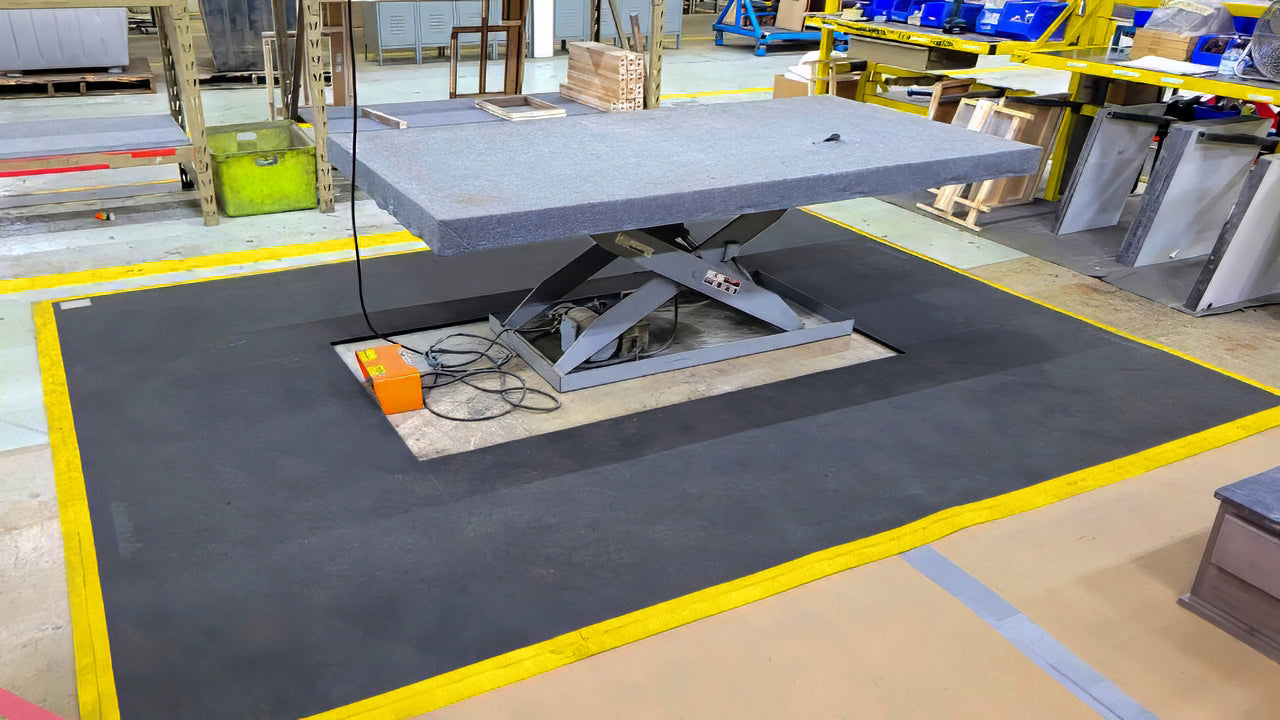After hundreds of anti-fatigue mats inspections over the past few years, we’ve seen a concerning practice emerge – employees are stacking their ergo mats. In fact, we polled more than 90 safety leaders in 2023, and over 40% report finding stacked mats in their manufacturing facilities.
While it may seem like a harmless solution to low-quality or flattened mats, stacking poses a significant threat to employee health. Here are 3 hidden dangers of stacking anti-fatigue mats – including insight from Certified Ergonomist, Mary Plehal.
Why Do Operators Stack Their Mats?
Stacking anti-fatigue mats typically occurs for 2 reasons. First, when mats become worn out and lose their anti-fatigue properties, employees resort to stacking old mats to compensate for diminished effectiveness.
Second, if employers invest in subpar matting products that lack adequate cushion and fatigue relief, employees often feel the need to stack multiple mats to create a more comfortable standing surface.
"Both signal a need for a thorough review of matting conditions and practices." says Mary.
 Stacked mats "expose employees to a higher risk of slips, trips, falls, and rolled ankles," says Ergonomist Mary Plehal.
Stacked mats "expose employees to a higher risk of slips, trips, falls, and rolled ankles," says Ergonomist Mary Plehal.
3 Hidden Dangers of Stacked Anti-Fatigue Mats
1. Uneven and Inconsistent Standing Surfaces
“It's common for stacked anti-fatigue mats to be different sizes, heights and products which creates uneven standing surfaces,” says Mary. “This is awkward and exposes employees to a higher risk of slips, trips, falls, and rolled ankles.”
The Bureau of Labor Statistics reports that slips, trips, and falls cause ~700 workplace fatalities each year. And countless more workplace injuries. The average trip and fall settlement? Over $100,000.
From an employee health and safety perspective, and your bottom line, recognizing and putting a stop to stacked anti-fatigue mats is an immediate and simple step you can take.
 Certified Ergonomist and Occupational Therapist, Mary Plehal, shares her experience with stacked anti-fatigue mats. Mary runs her own industrial ergonomics company called Optima EHS and was previously a corporate ergonomist for a global semiconductor manufacturer.
Certified Ergonomist and Occupational Therapist, Mary Plehal, shares her experience with stacked anti-fatigue mats. Mary runs her own industrial ergonomics company called Optima EHS and was previously a corporate ergonomist for a global semiconductor manufacturer.
2. Postural Instability
“The biggest concern from an ergonomic point of view is that double-stacked mats may seem to have subjectively more cushion which is perceived as a good thing,” says Mary. “In reality, it creates postural instability that causes the feet, ankles and upwards to the lower back to have to make constant micro-adjustments to maintain balance. This is similar to working in high heels day after day.”
Over time, this constant need for readjustment leads to discomfort, fatigue, and even chronic musculoskeletal (MSD) issues that employees may fail to associate with the mats themselves. According to the Occupational Safety and Health Administration, MSDs are the leading cause of absenteeism in manufacturing – costing companies more then $3 billion a year.
 Before-after in a facility for Andersen Windows. The team replaced stacked mats with a one-piece custom mat deigned to fit using AcroSketch. Made from 100% nitrile, the mat eliminates the need to stack mats by providing up to 8 years of ergonomic support.
Before-after in a facility for Andersen Windows. The team replaced stacked mats with a one-piece custom mat deigned to fit using AcroSketch. Made from 100% nitrile, the mat eliminates the need to stack mats by providing up to 8 years of ergonomic support.
3. Absenteeism and Turnover
Employees who stack their mats are doing so for a reason – they don’t think the mats are providing enough cushion or support. This discomfort and fatigue can lead to disengagement and higher turnover.
There are more than 900,000 open roles in manufacturing, a number that is expected to more than double within 5 years. Workers in this industry have options and are being selective. They're staying with companies that prioritize their health and leaving the ones that don't.
Neglecting to address stacked mats not only compromises health and safety, but can impact turnover, recruitment, productivity, and your bottom line.
 Summary: Invest and Educate
Summary: Invest and EducateThe practice of double-stacking anti-fatigue mats may seem like a quick fix for worn-out or inadequate matting conditions, but its dangers cannot be ignored. Uneven surfaces, awkward step-offs, postural instability, discomfort, and long-term health implications are just a few of the risks.
Make sure your people go home from work as healthy as when they arrived by investing in anti-fatigue mats with the right support, and by proactively educating all employees about the dangers of stacked mats.
 Left: Stacked mats creating trip hazards and MSD risks. Right: Single custom anti-fatigue mat designed to fit; consistent surface, thickness, and borders.
Left: Stacked mats creating trip hazards and MSD risks. Right: Single custom anti-fatigue mat designed to fit; consistent surface, thickness, and borders.
--
Get the cushion your team deserves. Get a free sample mat today:





